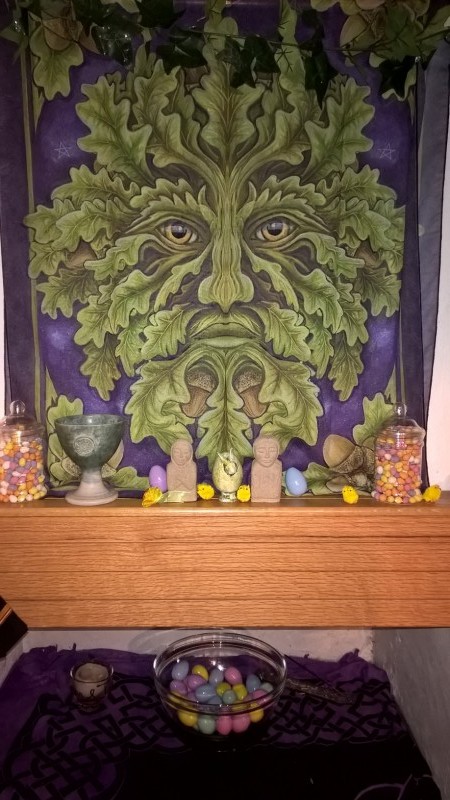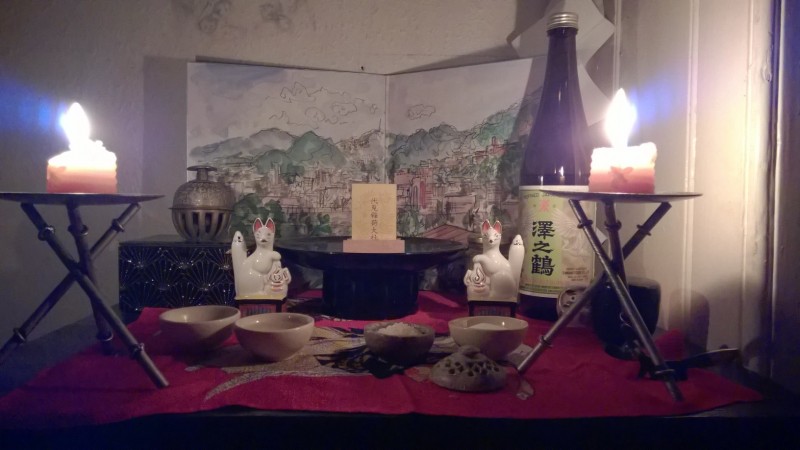It’s a question that has vexed many a person over the years. Is Shinto a religion or a way of life? It begs a further question: does it matter? At certain times in history it’s been a matter of vital importance, and as can be seen from the article below, it remains a puzzling issue even in the present. (The excerpt below is taken from a longer piece in the Asahi Shimbun about the Chichibu Festival.)
****************
Many Japanese freely mix religions depending on the occasion, visiting a Shinto shrine at New Year’s, holding a Buddhist funeral or getting married in a Christian wedding, a popular option even though only 1% of the population is Christian.
“I don’t know if that means we’re flexible or if we don’t have convictions,” Yamashita said.
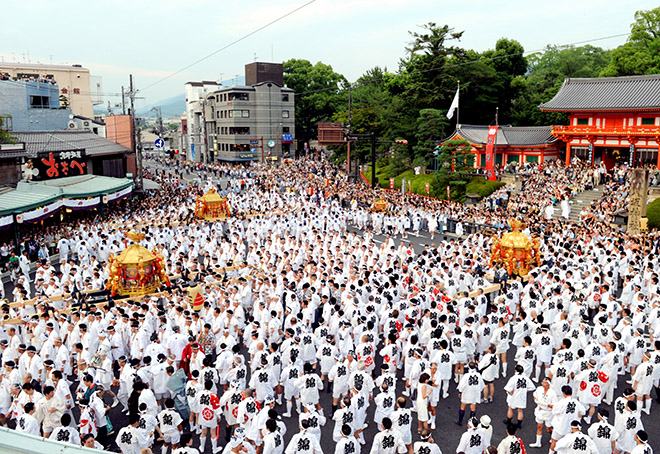
RELIGION SEEN DIFFERENTLY
Roaming the streets in the afternoon, a group of high school girls decked out in festival jackets and headbands who later joined in pulling the floats [at Chichibu Festival] said the festival wasn’t religious at all for them. And yet they emphatically said they believed the story about the two gods meeting that evening
“It’s romantic!” said Rea Kobayashi, 17. The girls also said they would celebrate Christmas with a decorated tree and gift-giving and didn’t see any problem mixing religions. “No problem! That’s normal. Most Japanese do that,” said Rio Nishimiya, 18. “We’re good at that. If it’s fun, that’s all that matters.”
“Japanese are flexible,” said her friend, Meiri Shimada, also 18. “That’s a good thing!” Such views are shared by many Japanese. Attitudes toward religion are ambiguous. Many would say they aren’t religious–and yet every year millions of Japanese visit Shinto shrines and Buddhist temples across Japan and have little shrines in their homes where they pray.
Religion is viewed differently in Japan, and in some other parts of Asia, than in the West or the Islamic world, where there is an emphasis on individual faith and a set of beliefs, or a creed, based on a sacred text such as the Bible or Koran.
In Japan, religion is more of a cultural, communal and ritualistic thing than a personal faith. Shinto has no sacred text or clearly defined theology, and many Japanese would be hard-pressed to summarize it, including many visitors to this festival.
“It’s a religion of life,” said Sonoda, the chief priest, in an attempt to summarize Shinto. “It’s something inherited from ancestors that provides a spirituality passed on from parent to child. And this isn’t just for humans, but we are also linked to animals and all living things. It’s because of them that we’re alive. Worldview may be a better way to describe it,” he said.
There are no definitive numbers on Shinto believers in Japan simply because there’s nothing definite to count. “We don’t use the phrase ‘believers,’” Sonoda said. There are no weekly services and no missionaries to spread Shinto.
COEXISTENCE
Sonoda said other folk religions share traits with Shinto. He recalls visiting a Hopi native American community years ago. They were holding a festival giving thanks to the spirits that lived in a nearby mountain and came down every spring to help the people with the planting season, and in winter would return to the mountain, he said. “That made a big impression on me,” he said.
There are more than 80,000 Shinto shrines across Japan, and nearly as many Buddhist temples, and the two have generally coexisted peacefully after Buddhism’s introduction to Japan in the 6th century, along with Confucian thought from China.
That long history of coexistence is one key reason behind Japanese attitudes toward religion.
“Each religion had a different role, and these three–Shinto, Buddhism and Confucianism–shaped Japanese culture,” said Susumu Shimazono, a professor of religion at Tokyo’s Sophia University, a Jesuit school. “There was some dogma, but none of these religions stressed exclusiveness. This sort of combination of ideas and philosophies is typical of East Asia.”
Experts say interest in Shinto among ordinary Japanese is holding steady or even increasing. As one measure of this, visitors to the Ise Grand Shrine, Japan’s most important shrine, have grown in recent years, running to 8.9 million through November, up from 7.8 million during the same period last year and 8.5 million for all of 2017.
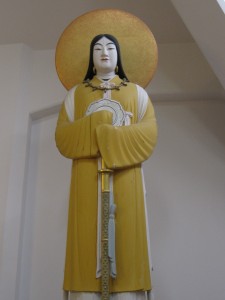
Shinto is also closely entwined with the Japanese imperial family, holding that the emperor is a descendant of the sun goddess Amaterasu Omikami.
It also has a dark recent past. During World War II, Shinto was elevated to the state religion and the war effort was fought in the name of the emperor, who was considered divine. After the war, the emperor was stripped of his divine stature, and the U.S.-drafted Constitution ensures freedom of religion and the separation of religion and state.
IMPERIAL FAMILY
But Shinto’s ties to the imperial family, and some religious rituals performed by the emperor, have generated controversy.
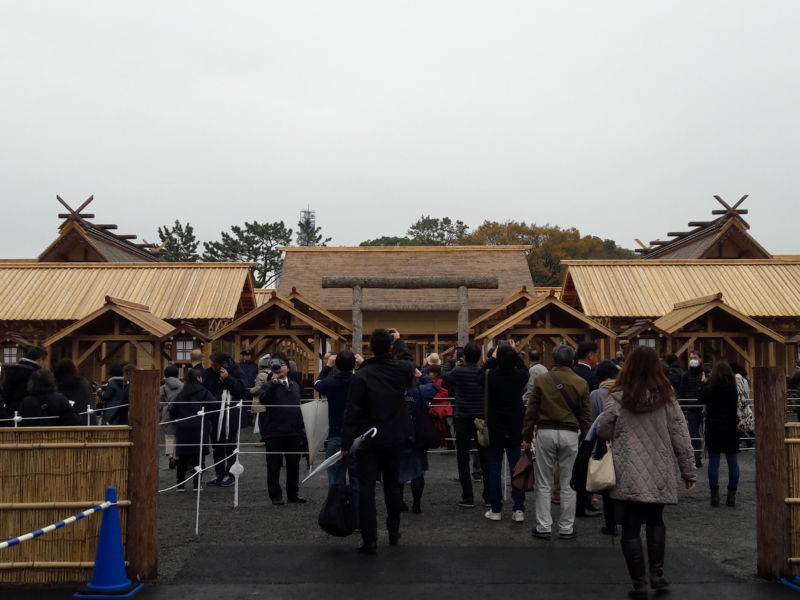
Last month, newly enthroned Emperor Naruhito spent the night in a makeshift shrine built (and which will later be demolished) with public funds in a ceremony called Daijosai, or the Great Thanksgiving. According to authorities, in this most important succession rite, he gave thanks for harvests, prayed for the peace and safety of the nation and hosted the imperial family’s ancestral gods.
All told, the event will cost 2.7 billion yen ($25 million) in public money. A group of 200 people filed a lawsuit last year against the government over the expenditure.
Crown Prince Akishino, Naruhito’s younger brother, said last year that he was against using state money for the ritual and raised questions about whether this was permissible under the separation of religion and state.
Visitors to the Chichibu festival were divided over the issue. “It’s a waste of money,” said 27-year-old Naoko Osada, of the ritual. “According to the Constitution, using public money for this is out of bounds,” said Akihiko Suzuki, a 73-year-old retired man. “But as Japanese, we entrust these sorts of things to authorities.”
Others said they believed Naruhito was fulfilling his duties as symbolic head of the country and that spending public money on such rites was acceptable so long as Shinto isn’t imposed on people.
“He’s our symbol, and it’s important to keep this tradition. So I don’t think it violates the Constitution,” said Nobuyuki Negishi, 44. “It’s OK for them to use state funds as long as they don’t use too much.”
SHINTO’S TWO ASPECTS
Sophia’s Shimazono said it’s helpful to view Shinto today as having two parts: state Shinto as a lingering political philosophy and the Shinto of the masses who go to shrines at New Year’s.
“State Shinto was rejected as a state religion after the war, but some of that sentiment remains today,” he said. “It has a large influence in politics.”
Rightwing groups such as Nippon Kaigi, which has ties to the ruling Liberal Democratic Party and Prime Minister Shinzo Abe, who is a special adviser to the group, would like to revise Japan’s pacifist Constitution and see Shinto increase its prominence.
That includes official visits to Tokyo’s Yasukuni Shrine, where Japan’s war dead, including war criminals, are memorialized. Politicians have avoided visiting Yasukuni because China and South Korea say that doing so glorifies Japan’s wartime leaders and past.
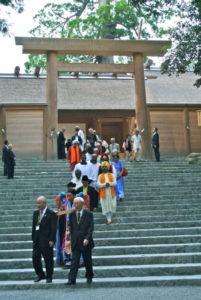
Abe drew attention to Shinto by hosting the 2016 Group of Seven summit in Ise-Shima and took fellow leaders to visit the Ise Grand Shrine, dedicated to the sun goddess. He also attended a once-every-20-years event at Ise in 2013, only the second prime minister to do so.
When you combine those political undercurrents with the cultural traditions maintained by millions who visit shrines every year — most of whom likely embrace freedom of religion — Shinto still “has a fairly large role in Japanese society,” Shimazono said.
Such political or even religious convictions, however, were far from the minds of most visitors to the Chichibu Night Festival. None of the two dozen people interviewed wanted a return to state Shinto, and few said the festival held religious significance for them, although some would say it held spiritual meaning.
“It’s so majestic!” exclaimed Tsuyoshi Koyama, a 47-year-old onlooker as all six huge floats with glowing lanterns gathered in the park at the festival’s climax and fireworks filled the sky. “Every day we have these mundane lives, and to see something this grand really stirs my heart.”
Koyama said he doesn’t consider himself devout and “prays only when I need help.” But he does believe that spirits live in the natural world around us, and “feels something spiritual in the atmosphere here.”
“Westerners tend to embrace one religion, but if you reduce it to one, that can cause conflicts,” he said. “The good part about Japan is that there are many gods, and they share generously with us.”

